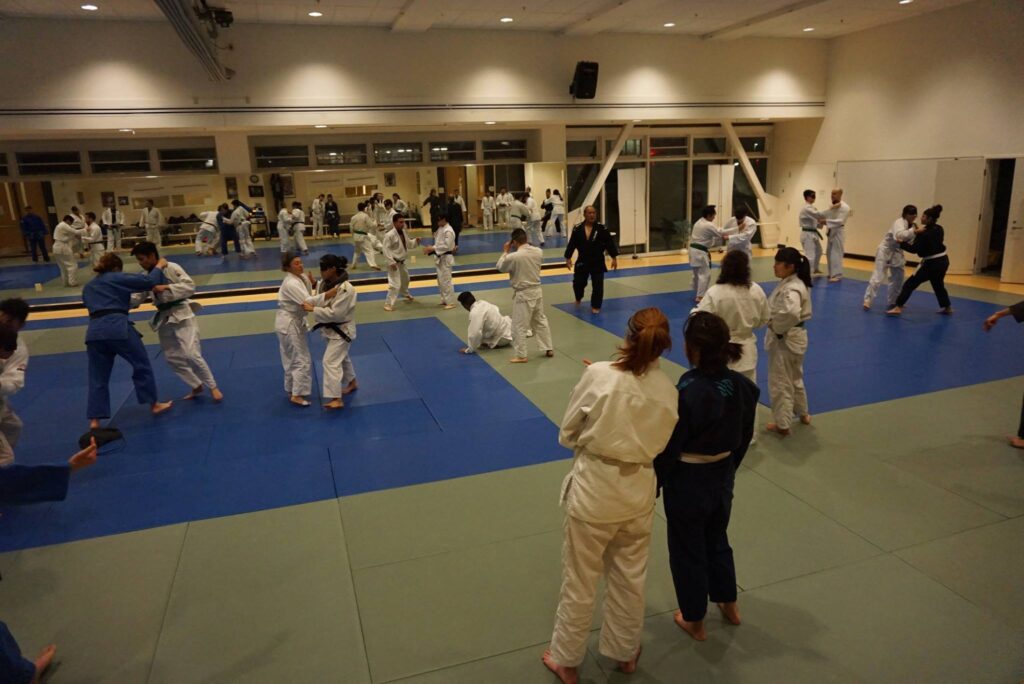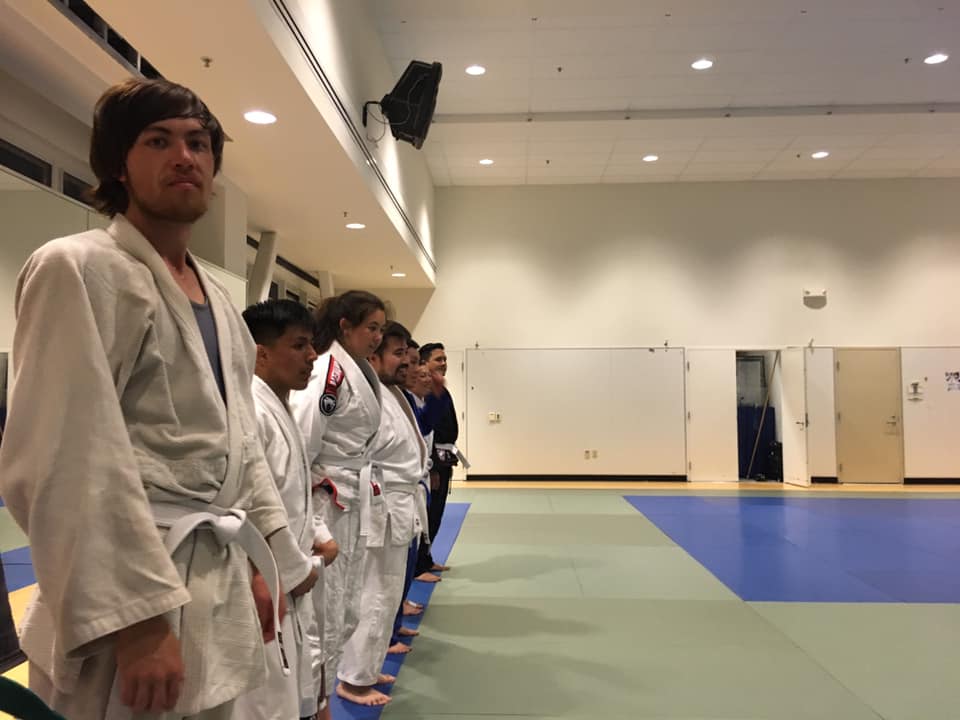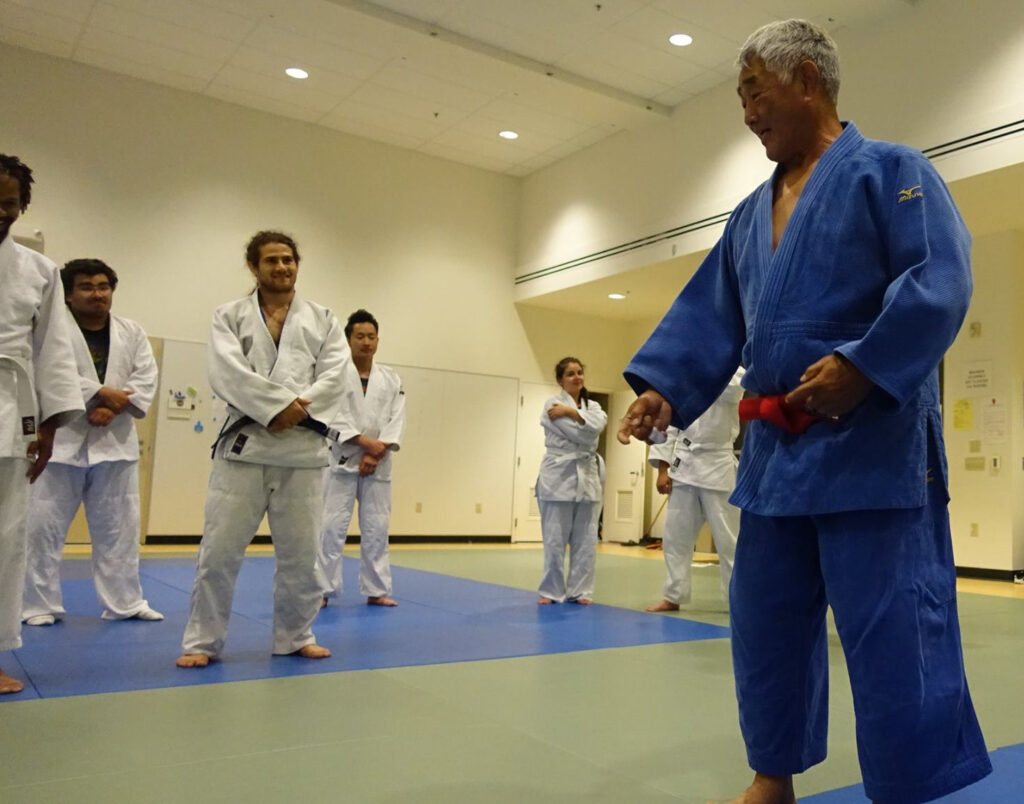The Practice of Judo

Judo Practice
Judo practice has many rules of etiquette, manners, and ethics. Above all, judo students learn important values of respect, respect for their instructors, or sensei; their partners, both senior and junior to them; the officials and referees of judo; the families and friends of judo classmates; and above all, themselves.
Learn More
Each dojo has its own code of conduct, spelling out the dos and don’ts of behavior. Judo students learn to be attentive, and develop a good work ethic that they can carry with them into others parts of their lives. Judo students learn modesty and fairplay. Values related to sincerity, courage, and commitment are fostered through the brutally honest actions of attack and defense.
Judo students learn to persevere in a physically and mentally demanding training that fosters emotional control and diligence. Judo students greet one another with respect and courtesy. In short, judo students learn much of the social etiquette necessary to become solid citizens of the world.
Philosophy of Judo Practice
THE PHILOSOPHY OF JUDO by Dr. Sachio Ashida, Hachidan (8th degree).
The average student is eager to learn the physical and technical side of Judo. The ukemi, nage-waza, osaekomi-waza and other forms of kata take up much of his attention. The “philosophy” seems to be pushed aside, forgotten or neglected.
Learn More
It is only upon witnessing the courtesy, the simple ritual of bowing before and after randori or a match that he realizes there is more to the sport than just working out or fighting. As he advances, he inadvertently is teaching a technique to his lesser-experienced partner. He then realizes the teacher/student concept of Judo. It is through these experiences and learning procedures that the student learns the general philosophy of Judo. Nevertheless, the mystery of the sport motivates him further to study and fortify this little known area of the philosophy.
He reads and hears Jigoro Kano’s two famous principles of “Maximum Efficiency, and Mutual Welfare and Benefit.” Kano outlined these two ultimate objects of Judo – the perfection of human character by his form of training methods using the above two principles. “Maximum Efficiency” means that whatever is planned, one should do with optimum use of mental and physical energy
In the practice and competition of Judo the player learns to throw with a minimum of effort but using to his benefit the opponent’s weakness, momentum and mistakes. His throws consist of a circle; his defense and counter-throws are made using the opponent’s circle of the throwing technique.
The application of this knowledge, by hard training, increases his proficiency and efficiency. By these methods, the principle of maximum efficiency is eventually mastered. The principle of mutual benefit and welfare takes longer to learn. This means that all students should help each other in advancing through judo training. This principle brings out love, respect and self-control – qualities manifested by many Judo masters.
By following these two principles, the student will progress toward his goal. But what is his goal? Each student must establish his own goal in life. The level of his goal depends upon his motivation. His Judo teacher may exemplify a model he wishes to emulate. Through Judo training, he can attain the characteristics of his teacher if the latter is a true Judo man. But what is the character of a true Judo man?
Many instructors use the same training methods but those who are not themselves developed morally and ethically achieve nothing. Any system of instruction depends on the excellence of those who are instructing. Proper Judo training produces respect, courage, patience, humility, flexibility, enthusiasm and reliability. As one judoka stated, “these are the characteristics that are most prized by all of humanity. The students must remember that many teachers fail to produce these traits in their students but the instructor never stops trying.
Judo, when learned and practiced properly, is a sport that “builds character.” The Judo community; however, feels that Judo and its philosophy contributes more in that it lets the student achieve his goals in life a little faster but not necessarily more easily. It is up to the student to train regularly, to discipline himself, to respect his peers and superiors, to participate in tournaments, to teach the lesser experienced and to study and learn the culture of judo.


The Goals of Judo
Judo has many faces–as a sport, self defense, exercise and philosophy. As a result, there are many goals that one can harbor through the practice of Judo. The most important goal, however, is the development of oneself as a person. To develop one’s character through Judo means to learn many of the same values, morals, and ethics passed on to the student from the instructor
Learn More
These values can be summarized by the two motto’s of Judo.
“Sei ryoku zen yo” – – to put our best efforts into everything
“Ji ta kyo ei” – – for the benefit of living with others harmoniously.
Judo teaches us to work as hard as we can, for the benefit of interpersonal relationships. These mottos can also be summarized by the last teachings of Jigoro Kano:
“Judo is the way to most efficiently use one’s mental and physical strength. By training, one should discipline and cultivate the body and spirit through the practice of techniques of offense and defense, thereby to master the essence of Judo. And, by these means, it is the ultimate goal of Judo to build oneself up to perfection and thereby benefit the world.”
Beyond the Black Belt
Around 1930 Jigoro Kano created a new colored belt to recognize the special achievements of those reaching high Dan ranking black belts of 6th Dan or above. These Dan grades became known as the Kodansha, meaning “person of high rank”, the “Ko” in this case meaning high, “Dan” meaning rank and “Sha” meaning person. However the actual recognition of Kodansha itself starts at 5th Dan, when it is deemed that a student has completed the school’s curriculum or syllabus of Judo techniques.
Learn More
Jigoro Kano chose to recognize the achievements of 6th, 7th, and 8th Dan black belts with a special “Obi” or belt, made of alternating red and white panels, known as the Kohaku Obi. The Japanese ideograph “Kohaku” may be directly translated as Red and White.
The Significance Of Red And White In Japanese Culture
The Genpei Wars between 1180 and 1185 were a conflict between the Taira and Minamoto clans, equally matched sides, in the late Heian period of Japan. These wars, however eventually, resulted in the downfall of the Taira clan and the establishment of the Kamakura Shogunate under Minamoto Yorimoto in 1192.
The Taira clan was often referred to as Heike and the Minamoto clan as Genji. They were identifiable on the battlefield by the use of colored flags. The Heike used red flags and the Genji white flags.
Following this war and its aftermath, the colors red and white, of the Taira and Minamoto standards, were established respectively, as Japan’s national colors. The white represented purity and peace, whilst the red represented not only the “Rising Sun” but the intensity within the Japanese people themselves, combined, the flag represented a national unity. This unity of colors represented the opposing sides of equal ability.
Opposing Sides Of Equal Ability
As a direct influence of this event, the Japanese began to use these two colors to represent opposing sides of equal ability, in just about any area of social cultural activity, whether through logical board games, sporting activities, Martial Arts or other areas of Japanese culture such as Chado (Tea ceremony) and Ikebana (Flower arranging).
These social cultural activities often resulted in contests against different schools, and the colors of red and white were used to differentiate the individual contestants or even the schools themselves, often by the wearing of small red or white ribbons.
The colors red and white are an enduring symbol of Japanese Culture, and they have been used in Judo since Jigoro Kano started the first ever Judo tournament, the Red and White Tournament, known as the Kohaku Shiai, in 1884. This tournament seems to have had a direct influence on Kano’s use of the Kohaku Obi.
![]() The “Kohaku Obi” — Red and White Paneled Belt
The “Kohaku Obi” — Red and White Paneled Belt
Generally, the Kohaku Obi is often worn for special ceremonial occasions only, it is not a requirement to be worn at all by Kodansha and the black belt still remains the standard attire for all the Yudansha (Black belts) ranks regardless of level.
The uses of the combined colors of red and white on one belt also have been a symbolic representation of the principles of harmony suggested by the balance of yin and yang. This use of contrasting colors is used throughout Japanese culture.
These colors represented the deeper symbolic philosophy of Yin and Yang, or opposite forces. The white representing purity, peace and calm whilst the red represents the intense desire to train and the sacrifices that have been made. Therefore the wearer has reached a level where these forces meet, they meet equally united, the opposing of complementary harmony.
Usually it is thought off, that the wearer using the Kohaku Obi is on a ceremonial function i.e. instructing formally, conducting a demonstration, a course or a seminar. If the holder is in general practice, i.e. regular training, randori training or still actively competing, it is the norm to still use the black belt.
In Japan, it is very rare for high Dan ranks, regardless of level, to outwardly display the wearing of the Kohaku Obi unless it is on a formal occasion. The very opposite can be said in the west, where it is common place for Kohaku Obi wearers to use the belt on a general day to day basis, regardless of occasion, although this practice can vary immensely between different associations.
Originally when Kano created the new Kohaku Obi, they were presented only to the 6th — 8th Dan seasoned veterans of the Kohaku Shiai, hence his natural use of the combined colors of Red and White.
Kohaku Dan Graded Syllabus
Generally, in the west, when practitioners have reached the level of 5th Dan, it is unusual for the individual to have to take another formal grading.
Most Judo associations hold an annual review, set up by a steering committee which usually includes members of their National Governing Board of Directors. This committee meets and assesses all current 5th Dan practitioners for suitability for further promotion to 6th Dan, the successful applicants will have had to meet several stringent guidelines, some which will contain minimum requirements such as time in present grade, competition achievement record and such areas as services to Judo. Also other areas such as current practice involvement, coaching ability, leadership, or research, publication, etc.
In some associations, 5th Dan or above can put forward proposals for themselves to be considered for higher Dan rank, in other associations the process is an automatic yearly evaluation of all 5th Dans.
Technical Dan Grade promotions require similar guidelines with the exception of competition achievement record.
The Kodokan, however require all higher Dan ranked individuals to be apt at Judo Kata, the performance of a stated designated Kata is still a requirement of senior grading from 6th to 8th Dan. At the Kodokan, these same candidates also undergo a written or verbal examination prior to any subsequent successful promotion.
The practice of Kata itself has somewhat been lost in the west in most associations, however there is currently a large resurgence towards Kata. The need to perform Kata for Dan grading of all levels, is now becoming a standard within a lot of Dan syllabi.
Beyond 8th Dan
Jigoro Kano also created the solid red belt to recognize 9th and 10th degree Yudansha. Very little is known behind this actual creation; however it is believed that the solid red, signifies the holder as having trained intensely for many years and sacrificed much in their pursuits of the study of Judo.
However for women, the difference between belt colors also still exists, with the solid red belt being an option for a Joshi Hachidan (woman 8th Dan), whereas for males it indicates a 9th Dan minimal.
There are no testing requirements for promotions to 9th or 10th Dan. Those promotions are based on time in grade, achievements and status by the promotions committee. In the entire history of Judo, there have been numerous promotions to 9th Dan, but very few to 10th Dan.
- However there does appear to be some definition to constitute the awarding of either a 9th or 10th Dan and they are as follows:
- The competitive record of the candidate
- The coaching record of the candidate
- Organizational leadership
- Refereeing and understanding the rules of competition
- Teaching of judo
- Creative contributions to judo
- Devotion to judo without a break.
- Kyuzo Mifune, 10th Dan, was once asked what made a person a 10th Dan and he answered “That the person should have added something new to the theory of Judo”. Mifune himself was famous for his analogy of the way a ball reacts when pushed, and this was apparently considered to be an important theoretical contribution to the theory of Judo.
- Kano also signified the use of a solid white belt for 10th Dan. This solid white belt would be off double width thickness to the usual beginners white belt, to signify the substantial difference and to recognize that holders of this rank would have come full circle….the final objective of any Judo student.

